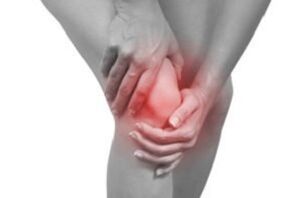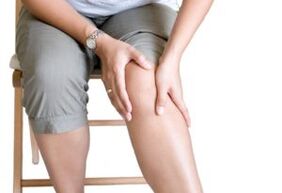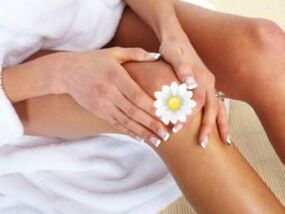
Of all the joints in the human body, knee pain is the most common complaint. The knee joint has a complex structure that takes a lot of load during various physical activities, so there are many reasons why you may experience pain. Knee pain, even if it happens occasionally and goes away on its own, should go unnoticed.
Knee pain, regardless of intensity, significantly reduces quality of life. With no pleasure from your favorite type of outdoor activity, efficiency drops, and a simple shopping trip becomes a problem.
In our article we will look at what to do if the knee joint hurts, how to treat it and whether it is possible to get rid of knee discomfort forever - the last question is especially relevantwith the elderly, those who are sedentary and have joint pain. syndrome indispensable companion of age.
Diagnosis of pain
- It is necessary to find out the nature of the pain. The pain can be sharp, burning, stabbing, stabbing.
- Eliminate cases of onset of pain - at night, after exertion, while walking, in the morning, sudden pain.
- Are there any other signs of joint damage: swelling, congestion (redness), joint deformity, crunching, limited range of motion.
- Check for a history of infection, stress, leg injury, or increased physical activity.
- Perform an instrumental examination at a medical and preventive facility (LPU) - blood tests, X-ray diagnostics, synovial fluid analysis.
Causes of knee pain
There are more than 200 joint diseases, most of which are accompanied by pain. Only on the basis of the complex of symptoms and examination can you determine the cause of your knee pain.
Traumatic pathology
In traumatic diseases, knee pain occurs with joint trauma (blows, falls, prolonged stress to the joint - typical for athletes) or with general pathologies of the body.
Let's take a look at the main traumatic pathologies.
Knee fracture
Broken or displaced patella, femur and/or tibia fracture. When you fall from above with your knees, in the case of a car accident, etc. v.
The victim has severe pain at the time of impact, over time the pain does not stop, may weaken slightly, but increases with pressure or walking.
The joint swells, deforms, fills with blood (joint sequelae), the knee fails to flex, and the kneecap becomes abnormally mobile.
Knee dislocation

It is characterized by displacement of the joints relative to each other. Knee dislocations have varying degrees of complexity (complete, incomplete, complicated by soft tissue rupture, etc. ).
Dislocations are usually caused by trauma to the knee or by birth defects: weak or overstretched ligaments, flat slide of the femur in the joint, excessively elevated patella.
Knee dislocation is a pretty serious injury, if not taken care of in time, everything can have dangerous complications. Knee dislocation is the most painful of all, although it is rare.
Serious injuries such as dislocations should be treated in a medical facility, not independent intervention. This is what traumatologists do.
Sprains, tendons, ligaments
Depending on the extent of the injury (partial break of each fiber, incomplete tear, complete break) symptoms appear: crunching and clackling during movement, bruising below the break site, limited flexion-stretching joint, knee swelling, joint too mobile. (with complete rupture of the ligament). The pain is sharp and intense, but with a minor injury, it may not appear immediately but after a while.
Bursitis
Periarticular bursitis due to trauma, infection, metabolic disorder, autoimmune disease. Usually occurs in athletes and people with increased body weight. Knee swelling, pain of varying intensity, but increases with exertion and at night.
Cupping tears
May be the result of trauma or degenerative changes in the cartilage tissue. Acute trauma is characterized by severe pain, swelling, and limited mobility. Symptoms for degenerative changes are mild.
Joint diseases
Knee pain can be a symptom of a medical condition.
We have listedThe most common diseases with knee pain syndrome:
Rheumatism
Diagnosis is much less common than in the 19th and 20th centuries. This is due to both the discovery of penicillin (and subsequent production of other antibiotics), and low diagnostic capacity in the past, when mostAll joint diseases are caused by rheumatic diseases.
The hallmark of rheumatism is alternating attacks of joint pain: first, one joint becomes inflamed, then the other. For example, knee pain lessens, but occurs in another large joint (elbow, hip).
Rheumatoid arthritis, which is more common in children and adolescents, develops after an upper respiratory streptococcal infection.
Note: advanced rheumatic disease leads to damage to the heart (rheumatic heart disease) or nervous system (chorea).
Reactive arthritis
It is more common in people of reproductive age, because arthritis is often caused by disease-causing bacteria that enter the human body through sex.
Less often, reactive arthritis is caused by a gastrointestinal or nasopharyngeal infection (pharyngitis, flu). After 1–4 weeks from the onset of the disease, the patient notices that his leg begins to hurt at night.
Both large joints (knees, ankles) and small joints (big toe pain) can become inflamed and painful. Knee pain accompanied by swelling and/or redness.
Sometimes symptoms include conjunctivitis (inflammation and pain in the eyes) and keratitis (thickening of the skin on the soles of the feet).
Reiter's syndrome
Urethritis (frequent, painful urination) and intestinal disturbances join the symptoms of common reactive arthritis.
Osteoarthritis
Diseases of the elderly. Periodic knee pain at night "because of the weather. " Loads on the joint (long walking) increase pain, swelling, and impaired mobility of the joint.
After resting and warming up, the pain should go away.
Baker's cyst
Swelling in the back of the knee, causing a feeling of spasm, difficulty in movement.
Osteomyelitis (Köning's disease)
The cartilage that covers the bone is peeled off, the knee joint hurts, when the fragment is completely removed, it will interfere with the movement of the joint.
Osgood-Schlatter disease
It is usually diagnosed in adolescents. Knee pain increases when going up and down stairs, squatting.
Rheumatoid arthritis
An autoimmune disease, the mechanism of which is unclear. It was found that cases started off as the usual list of immune systems: from stress and infection, to hypothermia. Immune bodies attack their own cells causing arthritis, especially the synovial lining of the joints.
Under the influence of immune cells, this membrane swells, increases in volume, and then begins to grow into nearby cartilage and bone tissue. The result of this process is knee pain, which becomes unbearable by the second half of the night.
The disease lasts many years, treated with non-steroidal anti-inflammatory drugs, corticosteroid hormones, gold preparations, immunosuppressants, antimalarial drugs.
Arising from improper metabolism. Due to alcohol abuse, "purine" products (meat, smoked meats, pickles).
Uric acid produced in the blood will be deposited in the joints as sodium urate crystals. The "sludge" is getting bigger and bigger, affecting the mobility of the joints, there is intense pain, the interval between attacks is decreasing.
Vascular pain in the knee is characterized by a sensation of tugging along the vein, sometimes the patient notices an acute tingling sensation.
Only a doctor, after a detailed examination, can tell why the knee hurts, if there is no obvious injury. It is not wise to rub your knees with a remedy that has "helped a neighbor". After all, what helps heal a joint injury can trigger an exacerbation of the disease's autoimmune mechanism.
Knee pain treatment
The doctor chooses a treatment regimen depending on the diagnosis.
Therapeutic measures against:
- with the etiology of the disease - infection, tumor, abnormal metabolism, impaired immune system.
- with pain syndrome - symptomatic treatment includes analgesics, intra-articular blockade.
- with degenerative processes - drugs with chondroprotectors help restore cartilage tissue of joints.
If necessary, surgery, arthroscopic surgery, the use of physiotherapy and therapeutic exercises for the joints can be resorted to.
Pain relief products
Checklist for people with knee pain - what to do to relieve the condition.
| Cause of pain | What |
|---|---|
| Obvious pain due to trauma | Apply joint and limb immobilization, and apply ice or cold compresses to the knee. Get medical attention immediately. |
| Pain in arthritis (reactive, rheumatic, etc. ) | Specific treatment with antibiotics and anti-inflammatory drugs is only prescribed by a doctor. For nocturnal pains, you can apply warm compresses, ointments based on bee venom. |
| Joint pain (people after injury, age, overweight) after exercise or at night | Heat with herbal tincture, apply ointments with chondroprotectors. |
Severe joint pain is relieved by non-steroidal anti-inflammatory drugs (NSAIDs).
But most patients (those who are overweight, age-related changes in the joints) won't have to think about what to do with the pain if they adhere to a minimum of precautions:
- Proper nutrition with adequate amounts of calcium, vitamins, anti-overweight;
- Reduces severe stress on joints until a job change, if it includes "standing on your feet" all day;
- Systematic physical therapy to strengthen muscles and ligaments - a good muscle corset helps to reduce the load on the bones;
Joint diseases can develop over the years and lead to a significantly impaired quality of life. Timely visits to the doctor and the stock of folk remedies will help maintain the joy of exercise into old age.
Treatment of joints at home - folk recipes
Homemade recipes for ointments and compresses are based on the natural ingredients used in the courses - this is the only way to achieve lasting results.
7 simple folk remedies for knee pain:
- Cabbage leaves. On a fresh leaf, cuts are made so that the juices come out. Put a spoonful of honey in the middle and put this "gauze" on the knee. The plate is fixed with tape. Wear the bandage all day or have the procedure done at night. The leaves of burdock and plantain are used in a similar way.
- Propolis tincture for arthritis. If the knee "twists" at night (the cause of the dull pain can be due to weather changes that put stress on the leg), lubricate the joint with the mixture, rubbing it into the skin until dry. If the knee hurts a lot, apply the whole body: soak the alcohol in a soft tissue and apply it to the joint, use a food wrap and wrap it. This tool is also used to warm up the joint if the knee is already cold. Likewise, they use tinctures from natural stimulants: aloe, Kalanchoe, mummy, dead bees.
Important:Biologically active substances cannot be used if the disease is of an autoimmune nature. Stimulants activate the immune system and make the disease worse.
- Compressed gelatin. A gauze soaked in hot water squeezed dry, 1 teaspoon of filling. gelatin, apply to joints, cover with foil and cover. Repeat the process for 14 days at night. The product promotes nutrition and regeneration of joint cartilage.
- Applying mustard is helpful if your knee is in severe pain. Take honey and dry mustard in equal proportions, add warm water and salt until a paste is formed. Lubricate the knee with the mixture, cover with a membrane cloth and cover. Contact time 20–40 minutes, Remove in case of severe burning sensation. Mustard dressings are used for pain relief every other day.
- To prevent foot pain, people prepare a medicine to drink: gelatin is added to 0. 5 liters of water in the evening, heated in the morning until dissolved. The mixture is taken before meals about ¼ - 1/2 glass, they drink for a month.
- Domestic goat fat (100 g) is mixed with balm "Zvezdochka" (1 vial), the resulting ointment is rubbed in for the treatment of venous and joint pain in the knee.
- Kefir mask. 0. 5 l kefir bread crumbs, add 1 tsp. Soft drink. The mixture is simmered for 6 hours. The fluid is then filtered, moistened with gauze, and compressed overnight for several days, until the pain disappears.

It is recommended to regularly apply home treatment with folk remedies, a combination of traditional medicine and modern methods. Do not wait until the disease is firmly established to declare itself with severe pain, joint deformity. Seeing a doctor early will help speed up recovery, while chronic disease will be more difficult to treat.
Note:Treatment with folk remedies is allowed only with the approval of a doctor, after examination and diagnosis.

















































